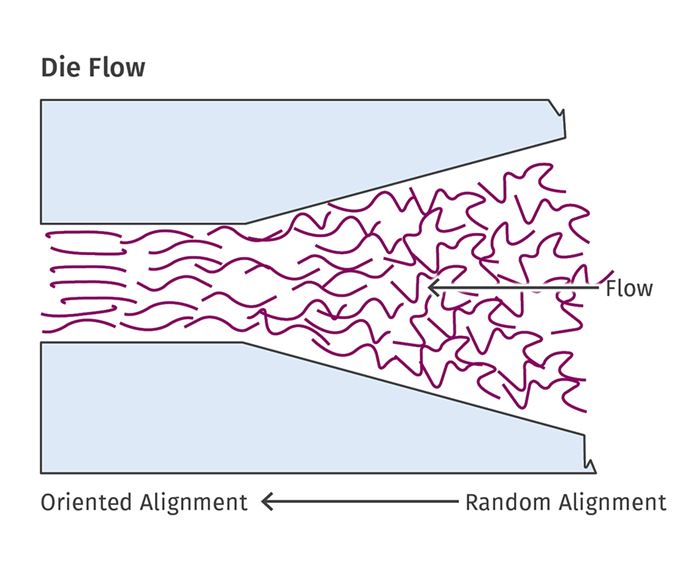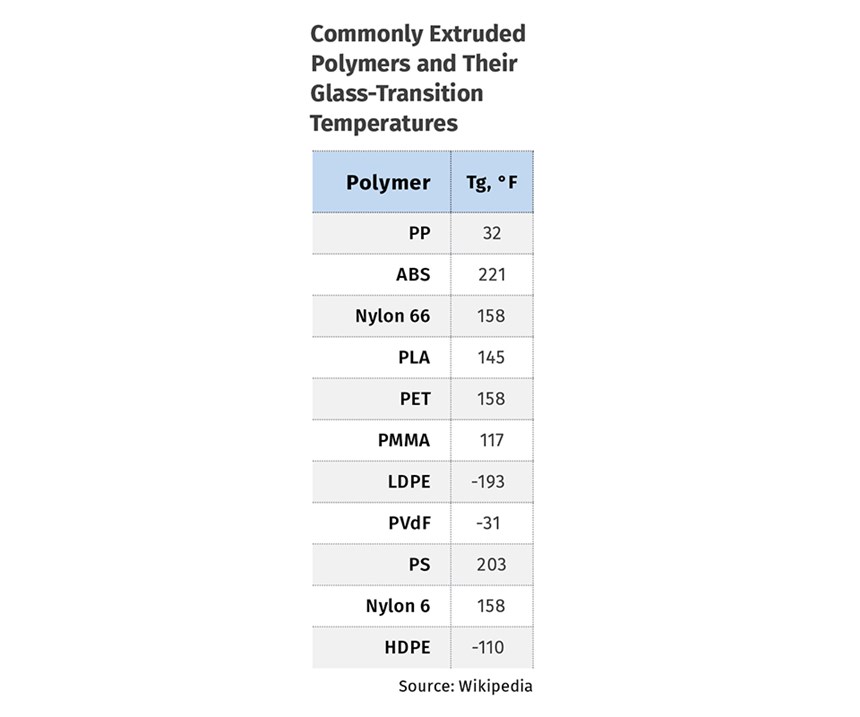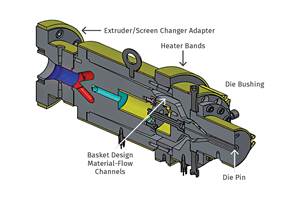EXTRUSION: Orientation: The Good and the Bad
Depending on what you are trying to accomplish, molecular orientation can have a positive or negative impact on your part. Here’s how to control it.
Molecular orientation occurs when melted polymer is sheared or stretched. If cooled quickly, this orientation is largely retained until the extrudate is reheated to a temperature that allows the molecular chains to move to their relaxed state.
Orientation can be beneficial or troublesome. It can be desirable when it is deliberately added to the extrudate. For example, it provides property improvements such as unidirectional strength in fibers, hoop strength in oriented extrusion blow molded bottles, and tear strength in oriented films. But in many extruded parts orientation can cause post-extrusion problems from non-uniform shrinkage and warpage.
Orientation occurs in every extrusion process due to the inherent strain applied to the long-chain molecules as the polymer is shaped and flows through the die. Some orientation through the die is unavoidable, and the magnitude depends on output rate for a given die design. A secondary annealing process is about the only way to reduce all orientation in extruded parts.
Polymer orientation can be measured for transparent polymers in the amorphous state by birefringence, and in both the amorphous and semi-crystalline state by infrared spectroscopy. The simple field test for orientation, often referred to as the “Chrysler test,” calls for cutting samples of the extruded part, accurately measuring them, and then subjecting them to heat for a few minutes at a temperature near the processing temperature. After that, the samples are cooled and measured again to determine the shrinkage and/or change in shape. The amount of dimensional change indicates the comparative degree of orientation in that area or direction.
In profiles with simple shapes, unbalanced orientation across the extruded cross-section can be reduced by optimizing the die-gap exit to be as dimensionally close to the final shape of the profile as possible to minimize exit velocity differences. In the case of flat sheet, for example, the die-exit gap should be as uniform as possible across the width.
A correctly designed die-flow geometry will result in the same velocity exiting the die across its full width. That’s not possible if the die slit is pinched down or opened up somewhere to balance the flow rate. The same is true of annular dies where the die gap has to be adjusted out of concentricity because of unbalanced flow to the die exit. This unbalanced flow of annular shapes occurs frequently in crosshead designs and blow molding dies. More complex extruded shapes with varying cross-sections can result in non-uniform velocity across the profile, resulting in unbalanced orientation that’s very difficult to eliminate, requiring post-extrusion heat treating to stabilize the shape.
Changes can be made in the die design to balance the velocity and the resulting orientation across the cross-section as the polymer passes through the die-gap exit. The more non-uniform and complicated the geometry, the more difficult this design
work becomes. It used to be done by the “cut-and-try” method but is now executed mostly by computer simulation along with practical experience.
That said, much of the undesirable orientation occurs after the extrudate exits the die and is stretched between the die exit and the hauloff. At this point the polymer is going through the temperature range where orientation effects are at their maximum, with immediate cooling locking in the orientation. This can be avoided simply by minimizing drawdown or neck-in as the extrudate leaves the die. This means setting a die gap as close to the finished product dimensions as possible, with precise takeaway velocity to minimize any stretching by pullers or rolls until the polymer sets up. Precise speed control of the downstream pulling/cooling equipment is the key to minimizing machine-direction orientation.
This portion of the orientation is within the control of the operator and does not need special expertise. Excessive drawdown after the die exit is mostly due to operators’ lack of knowledge of the effects and their reluctance to reset all the operating conditions for every profile change.
I have seen operators make several thicknesses of sheet, film, pipe, etc. from the same die gap using drawdown as an adjustment. By the same token, I have seen those same parts distort or even crack from exposure just to sunlight when placed under mild strain due to excessive orientation caused by drawdown.
The tendency for polymers to experience post-extrusion warpage and distortion from orientation is related to their glass-transition temperatures (Tg). Glass transition is the temperature at which the polymer changes from a rubbery consistency to a rigid structure. Molecular chain movement is greatly restricted below the Tg, so that any orientation largely remains in place. Once the Tg temperature is reached, the molecules have sufficient freedom of movement to reorder themselves into their more relaxed configuration to relieve the orientation. The level of temperature above the Tg largely determines the rate at which the relaxed state is reached.
The accompanying table lists commonly extruded polymers and their Tg. It shows whether orientation is expected to be a problem, depending on the service temperature expected for the part. On this list there are four polymers whose Tg is at or below the freezing point of water, meaning they will relax their orientation even at room temperature. Others with higher Tg will retain much of their orientation without appreciable shrinkage or distortion until raised to their Tg. However, almost all have a Tg below the temperature of boiling water.
ABOUT THE AUTHOR
Jim Frankland is a mechanical engineer who has been involved in all types of extrusion processing for more than 40 years. He is now president of Frankland Plastics Consulting, LLC. Contact jim.frankland@comcast.net or (724) 651-9196.
Related Content
Medical Tubing: Use Simulation to Troubleshoot, Optimize Processing & Dies
Extrusion simulations can be useful in anticipating issues and running “what-if” scenarios to size extruders and design dies for extrusion projects. It should be used at early stages of any project to avoid trial and error and remaking tooling.
Read MoreHow Polymer Melts in Single-Screw Extruders
Understanding how polymer melts in a single-screw extruder could help you optimize your screw design to eliminate defect-causing solid polymer fragments.
Read MoreHow to Select the Right Tooling for Pipe Extrusion
In pipe extrusion, selecting or building a complementary set of tooling often poses challenges due to a range of qualitative factors. Here’s some guidance to help you out.
Read MoreHow Screw Design Can Boost Output of Single-Screw Extruders
Optimizing screw design for a lower discharge temperature has been shown to significantly increase output rate.
Read MoreRead Next
Making the Circular Economy a Reality
Driven by brand owner demands and new worldwide legislation, the entire supply chain is working toward the shift to circularity, with some evidence the circular economy has already begun.
Read MorePeople 4.0 – How to Get Buy-In from Your Staff for Industry 4.0 Systems
Implementing a production monitoring system as the foundation of a ‘smart factory’ is about integrating people with new technology as much as it is about integrating machines and computers. Here are tips from a company that has gone through the process.
Read More
.jpg;width=70;height=70;mode=crop)





















